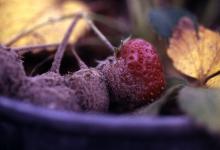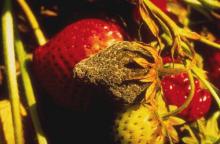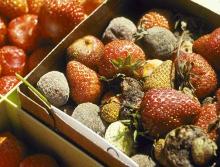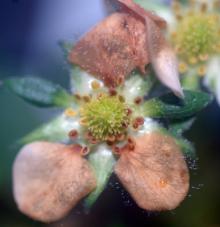Cause Botrytis cinerea, a fungus that overwinters as sclerotia or dormant mycelia in old leaves, petioles, and mummified fruit. Plants from nurseries can also be a source of fungi including ones that are resistant to fungicides. Conidia from within the planting are the principal inoculum and are produced readily and for a long time on diseased plant material. Conidia may infect leaves but infections generally remain symptomless until the leaf dies. Conidia readily infect the petals, stamens and pistils but not sepals. Flowers are most susceptible at anthesis. Mycelium then invades the developing fruit. Symptoms are generally delayed until fruit maturity and then progresses rapidly. No cultivar is immune, and even the least susceptible sustain considerable losses when environmental conditions favor disease development. The disease is more severe in high-density, double-row beds and with day neutral cultivars.
Several other Botrytis species have been described from rotted strawberries in Europe and eastern North America but were not prevalent in field surveys.
Symptoms Blossom blight is characterized by petals and pedicels that turn brown. The entire blossom may die. Fruit rot symptoms may occur on any portion of the fruit. They frequently develop at the calyx end and in tissues contiguous with rotting fruit or diseased flowers. Affected tissue turns light to medium brown. Lesions in green or white fruit develop slowly. The fruit may be misshapen as it enlarges. Fruit rot expands rapidly near harvest. In advanced stages, the fungus produces a gray fungal growth over the fruit surface. Rot may not develop until after fruit is harvested.
Cultural control
- Space plants so foliage dries rapidly after rain and irrigation.
- Use drip irrigation if possible. When using overhead irrigation, shorten sets and water at times that promote rapid drying of the foliage.
- Pick fruit as it ripens and move it quickly to cold storage.
- Shorten picking intervals, if possible, when weather favors Botrytis.
- After harvest, apply 10-10-10 (or equivalent well-balanced fertilizer) at 2 to 3 lb/100 feet of row.
- Time of renovation is important because fall fruit can provide considerable inoculum for the next growing season. In Oregon, it is recommended to renovate 2 to 4 weeks after the last harvest of June bearing types.
- Remove blossoms in the planting year.
- Under annual production in Florida, it was found that removal of senescent, dead leaves reduced the amount of gray mold but did not improve overall yield. Removal of diseased fruit during harvest did not reduce gray mold or increase yield.
- A one minute treatment of short-wave ultraviolet light (UV-C) followed by at least a 4 hour dark period resulted in less disease and may be useful in the greenhouse or tunnel production.
- Heat treatment of transplants prior to planting may be useful in some situations. Preheat plants at 99°F for an hour then move to 111°F for 4 hours.
Chemical control It is critical to begin applications during the bloom period. Start at first bloom and repeat at regular intervals, especially during wet weather, through to harvest. Several forecasting programs are available to help time applications (see below).
Fungal strains can become resistant to a fungicide when it is used exclusively in a spray schedule. To prevent developing resistant fungi, alternate or tank-mix materials from different groups with different modes of action. Alternating resistance-sensitive products with multi-site products, such as M3 or M4 fungicides, is recommended. Also, limit applications from any specific group to two (2) or fewer sprays. Selection of products for rotation and/or mixing must consider group 7 fungicides when used through the irrigation as a nematicide. Strains resistant to many different modes of action have been reported from the Eastern US and California as well as Germany and China. The frequency in the population is low but it is not uncommon to find strains resistant to 1 to 4 modes of action in the same isolate. Fitness of these fungi that are resistant to multiple classes of fungicide is lower than wild-type sensitive isolates. Surveys in Oregon from 2014 to 2017 found Botrytis resistant to fungicide groups 7, 9, and 17.
It has been suggested that fungicides used in nursery production should be different from those used for fruit production. Nurseries should consider the use of more multi-site materials rather than those at risk for resistance development.
- Affirm WDG at 6.2 oz/A. Can be used in structures but not open fields. Group 19 fungicide. 4-hr reentry.
- Bonide Captan 50 WP at 4 to 8 Tbsp/gal water can be used in home gardens. Washington only. H
- Captan 80 WDG at 1.9 to 3.75 lb/A. May be applied up to the day of harvest. Do not use with oil or alkaline materials. Moderately effective. Avoid use when honey bees are active due to larval toxicity. Group M4 fungicide. 24-hr reentry.
- CaptEvate 68 WDG at 3.5 to 5.25 lb/A. Can be used day of harvest. Avoid use when honey bees are active due to larval toxicity. Group 17 + M4 fungicide. 24-hr reentry.
- Cueva at 0.5 to 1 gal/100 gal water/A. May be used on day of harvest. Group M1 fungicide. 4-hr reentry. O
- Elevate 50 WDG at 1.5 lb/A. Can be used up to and including the day of harvest. Group 17 fungicide. 12-hr reentry.
- Fontelis at 16 to 24 fl oz/A plus another fungicide. Can be used day of harvest. Foliar reddening or speckling may occur in some cultivars. Group 7 fungicide. 12-hr reentry.
- Fracture (BLAD) at 24.4 to 36.6 fl oz/A. Reapply if rain occurs within 12 hours of original application. Do not use within one day of harvest. Group BM01 fungicide. 4-hr reentry.
- Inspire Super at 16 to 20 fl oz/A. Can be applied day of harvest. Group 3 + 9 fungicide. 12-hr reentry.
- Intuity at 6 fl oz/A. May be applied day of harvest. Group 11 fungicide. 12-hr reentry.
- JMS Stylet Oil at 3 quarts/100 gal water is registered, but its effectiveness in the Pacific Northwest is unknown. Tank-mix with another fungicide. Do not use during freezing temperatures, above 90°F, or when plants are under heat or moisture stress or wet. Do not use when foliage is wet as good coverage is essential. 4-hr reentry. O
- Kenja 400 SC at 13.5 to 15.5 fl oz/A. May be used up to and including day of harvest. Group 7 fungicide. 12-hr reentry.
- Luna Sensation at 6 to 7.6 fl oz/A. May be use day of harvest. Group 7 + 11 fungicide. Do not use if it was used for powdery mildew control the previous year. 12-hr reentry.
- Luna Tranquility at 16 to 27 fl oz/A. Do not use within 1 day of harvest. Group 7 + 9 fungicide. 12-hr reentry.
- Merivon at 8 to 11 fl oz/A. Do not use with EC or oil-based products. May be used day of harvest. Do not use if it was used for powdery mildew control the previous year. Group 7 + 11 fungicide. 12-hr reentry.
- Miravis Prime at 11.4 to 13.4 fl oz/A. May be used day of harvest. Group 7 + 12 fungicide. 12-hr reentry.
- Oso SC at 6.5 to 13 fl oz/A. May be applied on the day of harvest. Group 19 fungicide. 4-hr reentry.
- Ph-D WDG at 6.2 oz/A plus an adjuvant. May be applied on the day of harvest. Group 19 fungicide. 4-hr reentry.
- Problad Verde at 18.1 to 45.7 fl oz/A. Reapply if rain occurs within 12 hours of original application. Do not use within one day of harvest. Group BM01 fungicide. 4-hr reentry.
- Pristine at 18.5 to 23 oz/A. Can be used day of harvest. Do not use if it was used for powdery mildew control the previous year. Group 7 + 11 fungicide. 12-hr reentry.
- Regalia at 1 to 4 quarts/A. Use on 7-day intervals. May be used day of harvest. Does not benefit from the addition of an adjuvant. Group P5 fungicide. 4-hr reentry. O
- Rovral and other iprodione products (such as Meteor) are registered but cannot be used past first fruiting flower, which makes it useless for controlling fruit rot. It is also registered as a preplant soak for transplants to control crown rot. Use at 2 pints/100 gal water, soak plants for 5 min. and plant immediately. Group 2 fungicides. 24-hr reentry.
- Scala SC at 18 fl oz/A alone or 9 to 18 fl oz/A in a tank-mix. Do not apply within 1 day of harvest. See label about preventing spray drift in Willamette Valley Oregon areas with threatened or endangered species. Group 9 fungicide. 12-hr reentry.
- Sporan EC2 at 1 to 3 pints/100 gal water/A plus an adjuvant. Do not use when temperature equals or exceeds 90°F. May be used up to and including the day of harvest. Group BM01 fungicide. No reentry listed. O
- Switch 62.5 WG at 11 to 14 oz/A. May be used up to and including the day of harvest. Do not replant treated areas to anything other than crops listed on the label for 1 year after last application. Group 9 + 12 fungicide. 12-hr reentry.
- Tesaris at 6.9 to 9.1 fl oz/A. Do not use with oil based products. May be used day of harvest. Group 7 fungicide. 12-hr reentry.
- Thiram Granuflo at 4.4 lb/A. Do not use within 3 days of harvest. Moderately effective. Group M3 fungicide. 24-hr reentry.
Notes: Topsin M is registered for fruit rot control but is not recommended because resistant isolates of Botrytis are widespread, even on wild blackberries that have not been sprayed.
Some registered products offer only suppression of this disease and thus are not recommended for use. These products include Abound, Double Nickel 55, Evito, Flint Extra, Topguard EQ, and Vacciplant.
Protexio is registered but is not being sold due to the garlic-like odor it leaves on fruit.
Forecasting Several forecasting programs are available for scheduling fungicide applications. The model of Bulger utilizes leaf wetness and temperature during the wetness period as input variables. Using a threshold of disease flower incidence (INFBu) of 0.50, it was used successfully in Florida in which it also used fewer fungicide applications. It also worked well in Ohio under low disease pressure. The model of Broome (developed for grape) also worked well using a predicted fruit disease incidence threshold of 0.62 but used more fungicide applications. The model of Xu, based on field data to predict the incidence of diseased flowers, required more fungicide applications without improving disease control. None of these have been evaluated in the PNW.
Biological control The use of Bacillus-based biological fungicides was of questionable value for profitable return on application investment in annual strawberry production in Florida.
- Actinovate AG (Streptomyces lydicus strain WYEC 108) at 3 to 12 oz/A plus a spreader-sticker. Do not mix with Regalia or certain copper- or sulfur-based products. Use when temperature is above 45F. Two trials averaged 50% control. 4-hr reentry. O
- Botector (Aureobasidium pullulans strains DSM 14940 and 14941) at 5 to 10 oz/A depending on water volume. Can be applied day of harvest. Compatible with sulfurs, oils and a few fungicides but not with many synthetic fungicides. 4-hr reentry. O
- BotryStop (Urocladium oudemansii U3 strain) at 2 to 4 lb/A. Keep refrigerated before use. Compatible with many wetting agents, some fungicides, and biologicals but not all. Unknown efficacy in the PNW but was not effective in 2 Florida trials. 4-hr reentry. O
- Howler Evo (Pseudomonas chlororaphis strain AFS009) at 20 to 120 oz /A plus a surfactant. Can be used day of harvest. Unknown efficacy in the PNW but not effective in a few Florida trials. 4-hr reentry. O
- LALStop G46 WG (Clonostachys rosea [formerly Gliocladium catenulatum] strain J1446) at 0.3 to 16 oz/A. Do not use with other products in the tank. 4-hr reentry. O
- Serenade OPTI (Bacillus subtilis strain QST 713) at 14 to 20 oz /A. Active ingredient is a small protein. 4-hr reentry. O
- Stargus (Bacillus amyloliquefaciens strain F727) at 1 to 4 quarts/A plus a nonionic surfactant. May be used day of harvest. Unknown efficacy in the PNW. 4-hr reentry. O
References Cordova, L.G., Dalla Lana, F., Paul, P.A., and Peres, N.A. 2019. A Quantitative Synthesis of the Efficacy and Profitability of Conventional and Biological Fungicides for Botrytis Fruit Rot Management on Strawberry in Florida. Plant Disease 103:2505-2511.
Gama, A. B., Cordova, L. G., Baggio, J. S., Mertely, J. C. and Peres, N. A. 2023. Old but Gold: Captan Is a Valuable Tool for Managing Anthracnose and Botrytis Fruit Rots and Improving Strawberry Yields Based on a Meta-Analysis. Plant Disease, 107:3071-3078.
Janisiewicz, W.J., Takeda, F., Glenn, D.M., Camp, M.J., and Jurick, W.M. 2016. Dark period following UV-C treatment enhances killing of Botrytis cinerea conidia and controls gray mold of strawberries. Phytopathology 106:386-394.
Strømeng, G.M., Hjeljord, L.G., and Stensvand, A. 2009. Relative contribution of various sources of Botrytis cinerea inoculum in strawberry fields in Norway. Plant Disease 93:1305-1310.





